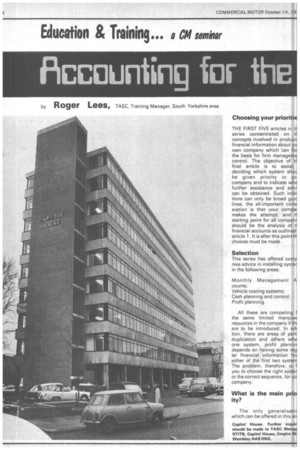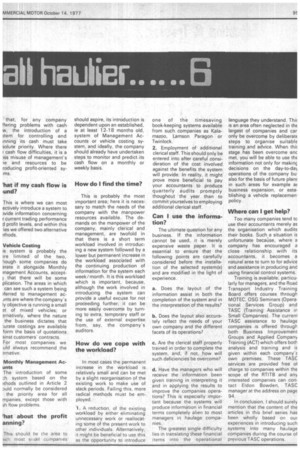Accounting for the
Page 96

Page 97

If you've noticed an error in this article please click here to report it so we can fix it.
by Roger Lees, TASC, Training Manager, South Yorkshire area Choosing your prioritie
THE FIRST FIVE articles in t[ series concentrated on tl concepts involved in producii financial information about ye own company which 'can for the basis for firm manageme control. The objective of tt final article is to assist deciding which system shou be given priority in ye company and to indicate whe further assistance and advi can be obtained. Such indic tions can only be broad guic lines, the all-important consi eration is that your compa makes the attempt, and tl starting point for all compani should be the analysis of tl financial accounts as outlined article 1. It is after this point th choices roust be made.
This series has offered comp nies advice in installing system in the following areas:
Selection
Monthly Management A counts; Vehicle costing systems: Cash planning and control; Profit planning.
All these are competing f the same limited manpow resources in the company if thi are to be introduced. In ad( tion, there are areas of part duplication and others whe one system, profit plannin depends on having some reg lar financial information fro either of the first two system The problem, therefore, is f you to choose the right syster or the correct sequence, for yo company.
What is the main prio ity?
The only generalisatic which can be offered in this an
Capitol House. Further inquir should be made to TASC Manag RTIT13, Capitol House, Empire VIal, Wembley HA9 ONG.
that, for any company ffering problems with cash• w, the introduction of a ;tem for controlling and inning its cash must take solute priority. Where there cash flow difficulties, it is a )ss misuse of management's le and resources to be roducing profit-oriented syms.
hat if my cash flow is ,und?
This is where we can most ectively introduce a system to wide information concerning r current trading performance d profit levels, and within this ies we offered two alternative ithods.
Vehicle Costing is system is probably the >re limited of the two, hough some companies do Nate it alongside Monthly inagement Accounts, accept
I that there will be some plication. The' areas in which can see such a system being ?ferred to management ac,Ints are where the company's ly objective is running a small at of mixed vehicles; or ?.rnatively, where the nature the business dictates that urate castings are available form the basis of quotations 3inst customers' contracts. For most companies. we uld always recommend the .3rnative.
Monthly Management Acunts
The introduction of some Th system based on the thods outlined in Article 2 Duld normally be considered the priority area for all mpanies, except those with 3h flow problems.
Phat' about the profit anning?
This should be the area to Itch Most small companies should aspire, its introduction is dependent upon an established, ie at least 12-18 months old, system of Management Accounts or vehicle costing system, and ideally, the company should already have undertaken steps to monitor and predict its cash flow on a monthly or weekly basis.
How do I find the time?
This is probably the most important area;, here it is necessary to match the needs of the company with the manpower resources available. The demands on the manpower of the company, mainly clerical and management, are twofold in that there is a short term workload involved in introducing a new system followed by a lower but permanent increase in the workload associated with the continuing production of information for the system each week/month. It is this workload which is important, because, although the work involved in introducing the system can provide a useful excuse for not proceeding further, it can be more easily overcome by turning to extra, temporary staff or the use of external expertise from., say, the company's auditors.
How do we cope with the workload?
In most cases the permanent increase in the workload is relatively small and can be met by a slight reorganisation of the existing work to make use of slack periods. Failing this, more radical methods must be employed.
1. A reduction, o-f the existing workload by either eliminating unnecessary work or reallocating some of the present work to other individuals. Alternatively, it might be beneficial to use this as the opportunity to introduce
one of the timesaving book-keeping systems available from such companies as Kalamazoo, Lamson Paragon or Twinlock.
2. Employment of additional clerical staff. This should only be entered into after careful consi6ration of the cast involved against the benefits the system will provide. In reality, it might prove more beneficial to pay your accountants to produce quarterly audits promptly thoughout the year than to commit yourselves to employing additional clerical staff.
Can I use the information?
The ultimate question for any business. If the information cannot be used, it is 'merely expensive waste paper. It is essential to ensure that the following points are carefully considered before the installation of the selected system(s) and are modified in the light of experience.
a. Does the layout of the information assist in both the completion of the system and in the interpretation of the results?
b. Does the layout also accurately reflect the needs of your own company and /he different facets of its operations?
c. Are the clerical staff properly trained in order to complete the system, and, if not, how will such deficiencies be overcome?
d. Have the managers who will receive the information been given training in interpreting it and in applying the results to improve the companies operations? This is especially important because the systems will produce information in financial terms completely alien to most managers in haulage companies.
The greatest single difficulty lies in translating these financial items into the operational
language they understand. This is an area often neglected in thE largest of companies and car only be overcome by deliberatE steps to organise suitable training and advice. When this stage has been overcome anc met, you will be able to use thE information not only for makinc decisions on the day-to-da) operations of the company bu. also for the basis of future plans in such areas for example as business expansion, or establishing a vehicle replacemerr policy.
Where can I get help?
Too many companies tend to use their accountants merely as the organisation which audits their books. Such a situation is unfortunate becatIse, where a company has encouraged a close relationship with its accountants, it becomes a natural area to turn to for advice and assistance in producing and using financial control systems.
Training is available; particularly for managers, and the Road Transport Industry Training Board offers courses through MOTEC, OSG Seminars (Operational Services Group) and TASC (Training' Assistance in Small Companies). The curreni TASC assistance to haulage companies is offered through both Business Improvement Groups and Applied Company Training (ACT) which offers both analysis and training and is given within each company's own premises. These TASC services are provided free ol charge to companies within the scope of the RT1TB and any interested companies can contact Eldon Bowden, TASC manager at the address on page 94.
In conclusion, I should surely mention that the content of the articles in this brief series has been wholly based on our experiences in introducing such systems into many haulage companies during the course of previous TASC operations.












































































































































































